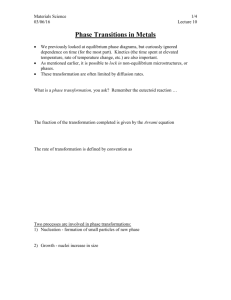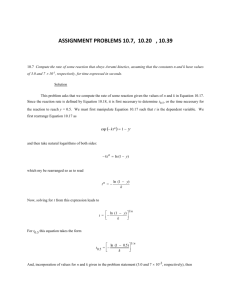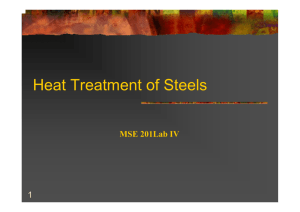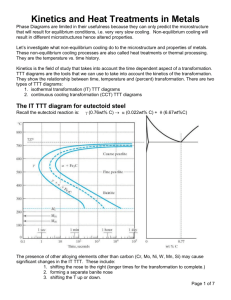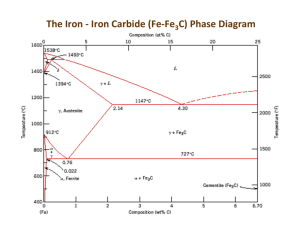Isothermal Transformation Diagrams
advertisement
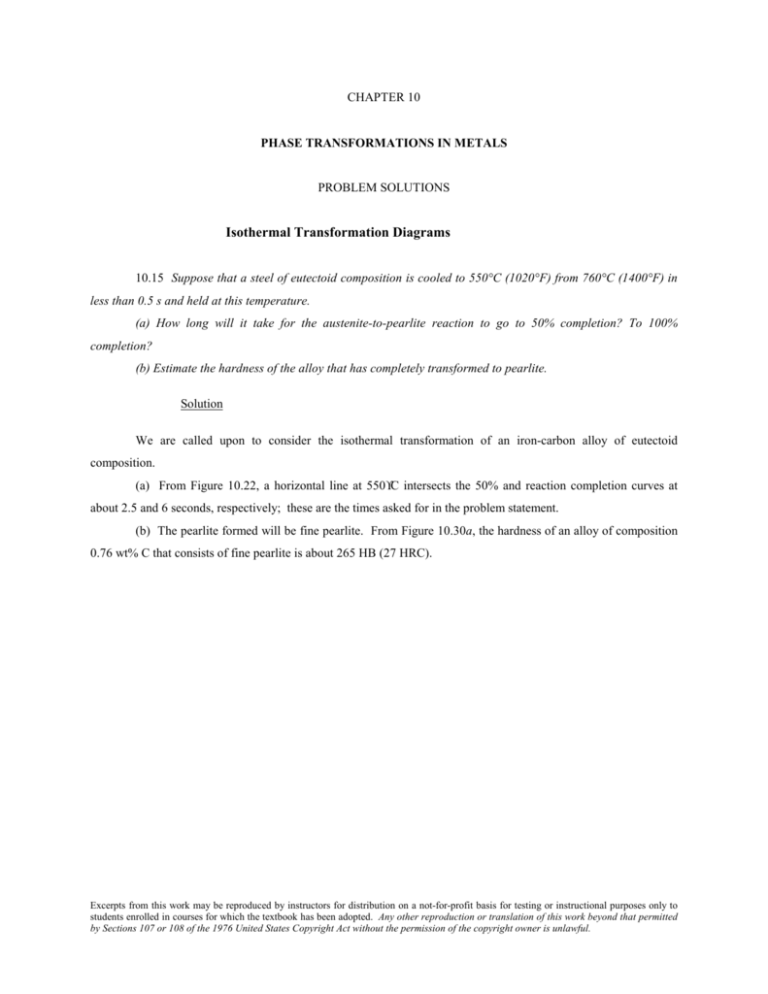
CHAPTER 10 PHASE TRANSFORMATIONS IN METALS PROBLEM SOLUTIONS Isothermal Transformation Diagrams 10.15 Suppose that a steel of eutectoid composition is cooled to 550°C (1020°F) from 760°C (1400°F) in less than 0.5 s and held at this temperature. (a) How long will it take for the austenite-to-pearlite reaction to go to 50% completion? To 100% completion? (b) Estimate the hardness of the alloy that has completely transformed to pearlite. Solution We are called upon to consider the isothermal transformation of an iron-carbon alloy of eutectoid composition. (a) From Figure 10.22, a horizontal line at 550°C intersects the 50% and reaction completion curves at about 2.5 and 6 seconds, respectively; these are the times asked for in the problem statement. (b) The pearlite formed will be fine pearlite. From Figure 10.30a, the hardness of an alloy of composition 0.76 wt% C that consists of fine pearlite is about 265 HB (27 HRC). Excerpts from this work may be reproduced by instructors for distribution on a not-for-profit basis for testing or instructional purposes only to students enrolled in courses for which the textbook has been adopted. Any other reproduction or translation of this work beyond that permitted by Sections 107 or 108 of the 1976 United States Copyright Act without the permission of the copyright owner is unlawful. 10.16 Briefly cite the differences between pearlite, bainite, and spheroidite relative to microstructure and mechanical properties. Solution The microstructures of pearlite, bainite, and spheroidite all consist of α-ferrite and cementite phases. For pearlite, the two phases exist as layers which alternate with one another. Bainite consists of very fine and parallel needle-shaped particles of cementite that are surrounded an α-ferrite matrix. For spheroidite, the matrix is ferrite, and the cementite phase is in the shape of sphere-shaped particles. Bainite is harder and stronger than pearlite, which, in turn, is harder and stronger than spheroidite. Excerpts from this work may be reproduced by instructors for distribution on a not-for-profit basis for testing or instructional purposes only to students enrolled in courses for which the textbook has been adopted. Any other reproduction or translation of this work beyond that permitted by Sections 107 or 108 of the 1976 United States Copyright Act without the permission of the copyright owner is unlawful. 10.17 What is the driving force for the formation of spheroidite? Solution The driving force for the formation of spheroidite is the net reduction in ferrite-cementite phase boundary area. Excerpts from this work may be reproduced by instructors for distribution on a not-for-profit basis for testing or instructional purposes only to students enrolled in courses for which the textbook has been adopted. Any other reproduction or translation of this work beyond that permitted by Sections 107 or 108 of the 1976 United States Copyright Act without the permission of the copyright owner is unlawful. 10.18 Using the isothermal transformation diagram for an iron–carbon alloy of eutectoid composition (Figure 10.22), specify the nature of the final microstructure (in terms of microconstituents present and approximate percentages of each) of a small specimen that has been subjected to the following time–temperature treatments. In each case assume that the specimen begins at 760°C (1400°F) and that it has been held at this temperature long enough to have achieved a complete and homogeneous austenitic structure. (a) Cool rapidly to 700°C (1290°F), hold for 104 s, then quench to room temperature. Solution Below is Figure 10.22 upon which is superimposed the above heat treatment. After cooling and holding at 700°C for 104 s, approximately 50% of the specimen has transformed to coarse pearlite. Upon cooling to room temperature, the remaining 50% transforms to martensite. Hence, the final microstructure consists of about 50% coarse pearlite and 50% martensite. (b) Reheat the specimen in part (a) to 700°C (1290°F) for 20 h. Solution Excerpts from this work may be reproduced by instructors for distribution on a not-for-profit basis for testing or instructional purposes only to students enrolled in courses for which the textbook has been adopted. Any other reproduction or translation of this work beyond that permitted by Sections 107 or 108 of the 1976 United States Copyright Act without the permission of the copyright owner is unlawful. Heating to 700°C for 20 h the specimen in part (a) will transform the coarse pearlite and martensite to spheroidite. (c) Rapidly cool to 600°C (1110°F), hold for 4 s, rapidly cool to 450°C (840°F), hold for 10 s, then quench to room temperature. Solution Below is Figure 10.22 upon which is superimposed the above heat treatment. After cooling to and holding at 600°C for 4 s, approximately 50% of the specimen has transformed to pearlite (medium). During the rapid cooling to 450°C no transformations occur. At 450°C we start timing again at zero time; while holding at 450°C for 10 s, approximately 50 percent of the remaining unreacted 50% (or 25% of the original specimen) will transform to bainite. And upon cooling to room temperature, the remaining 25% of the original specimen transforms to martensite. Hence, the final microstructure consists of about 50% pearlite (medium), 25% bainite, and 25% martensite. (d) Cool rapidly to 400°C (750°F), hold for 2 s, then quench to room temperature. Excerpts from this work may be reproduced by instructors for distribution on a not-for-profit basis for testing or instructional purposes only to students enrolled in courses for which the textbook has been adopted. Any other reproduction or translation of this work beyond that permitted by Sections 107 or 108 of the 1976 United States Copyright Act without the permission of the copyright owner is unlawful. Solution Below is Figure 10.22 upon which is superimposed the above heat treatment. After cooling to and holding at 400°C for 2 s, no of the transformation begin lines have been crossed, and therefore, the specimen is 100% austenite. Upon cooling rapidly to room temperature, all of the specimen transforms to martensite, such that the final microstructure is 100% martensite. (e) Cool rapidly to 400°C (750°F), hold for 20 s, then quench to room temperature. Solution Below is Figure 10.22 upon which is superimposed the above heat treatment. Excerpts from this work may be reproduced by instructors for distribution on a not-for-profit basis for testing or instructional purposes only to students enrolled in courses for which the textbook has been adopted. Any other reproduction or translation of this work beyond that permitted by Sections 107 or 108 of the 1976 United States Copyright Act without the permission of the copyright owner is unlawful. After cooling and holding at 400°C for 20 s, approximately 40% of the specimen has transformed to bainite. Upon cooling to room temperature, the remaining 60% transforms to martensite. Hence, the final microstructure consists of about 40% bainite and 60% martensite. (f) Cool rapidly to 400°C (750°F), hold for 200 s, then quench to room temperature. Solution Below is Figure 10.22 upon which is superimposed the above heat treatment. Excerpts from this work may be reproduced by instructors for distribution on a not-for-profit basis for testing or instructional purposes only to students enrolled in courses for which the textbook has been adopted. Any other reproduction or translation of this work beyond that permitted by Sections 107 or 108 of the 1976 United States Copyright Act without the permission of the copyright owner is unlawful. After cooling and holding at 400°C for 200 s, the entire specimen has transformed to bainite. Therefore, during the cooling to room temperature no additional transformations will occur. Hence, the final microstructure consists of 100% bainite. (g) Rapidly cool to 575°C (1065°F), hold for 20 s, rapidly cool to 350°C (660°F), hold for 100 s, then quench to room temperature. Solution Below is Figure 10.22 upon which is superimposed the above heat treatment. Excerpts from this work may be reproduced by instructors for distribution on a not-for-profit basis for testing or instructional purposes only to students enrolled in courses for which the textbook has been adopted. Any other reproduction or translation of this work beyond that permitted by Sections 107 or 108 of the 1976 United States Copyright Act without the permission of the copyright owner is unlawful. After cooling and holding at 575°C for 20 s, the entire specimen has transformed to fine pearlite. Therefore, during the second heat treatment at 350°C no additional transformations will occur. Hence, the final microstructure consists of 100% fine pearlite. (h) Rapidly cool to 250°C (480°F), hold for 100 s, then quench to room temperature in water. Reheat to 315°C (600°F) for 1 h and slowly cool to room temperature. Solution Below is Figure 10.22 upon which is superimposed the above heat treatment. Excerpts from this work may be reproduced by instructors for distribution on a not-for-profit basis for testing or instructional purposes only to students enrolled in courses for which the textbook has been adopted. Any other reproduction or translation of this work beyond that permitted by Sections 107 or 108 of the 1976 United States Copyright Act without the permission of the copyright owner is unlawful. After cooling and holding at 250°C for 100 s, no transformations will have occurred—at this point, the entire specimen is still austenite. Upon rapidly cooling to room temperature in water, the specimen will completely transform to martensite. The second heat treatment (at 315°C for 1 h)—not shown on the above plot—will transform the material to tempered martensite. Hence, the final microstructure is 100% tempered martensite. Excerpts from this work may be reproduced by instructors for distribution on a not-for-profit basis for testing or instructional purposes only to students enrolled in courses for which the textbook has been adopted. Any other reproduction or translation of this work beyond that permitted by Sections 107 or 108 of the 1976 United States Copyright Act without the permission of the copyright owner is unlawful. 10.19 Make a copy of the isothermal transformation diagram for an iron–carbon alloy of eutectoid composition (Figure 10.22) and then sketch and label time–temperature paths on this diagram to produce the following microstructures: (a) 100% fine pearlite (b) 100% tempered martensite (c) 50% coarse pearlite, 25% bainite, and 25% martensite Solution Below is shown the isothermal transformation diagram for a eutectoid iron-carbon alloy, with timetemperature paths that will yield (a) 100% fine pearlite; (b) 100% tempered martensite; and (c) 50% coarse pearlite, 25% bainite, and 25% martensite. Excerpts from this work may be reproduced by instructors for distribution on a not-for-profit basis for testing or instructional purposes only to students enrolled in courses for which the textbook has been adopted. Any other reproduction or translation of this work beyond that permitted by Sections 107 or 108 of the 1976 United States Copyright Act without the permission of the copyright owner is unlawful. 10.26 Briefly explain why there is no bainite transformation region on the continuous cooling transformation diagram for an iron–carbon alloy of eutectoid composition. Solution There is no bainite transformation region on the continuous cooling transformation diagram for an ironcarbon alloy of eutectoid composition (Figure 10.25) because by the time a cooling curve has passed into the bainite region, the entirety of the alloy specimen will have transformed to pearlite. Excerpts from this work may be reproduced by instructors for distribution on a not-for-profit basis for testing or instructional purposes only to students enrolled in courses for which the textbook has been adopted. Any other reproduction or translation of this work beyond that permitted by Sections 107 or 108 of the 1976 United States Copyright Act without the permission of the copyright owner is unlawful.


